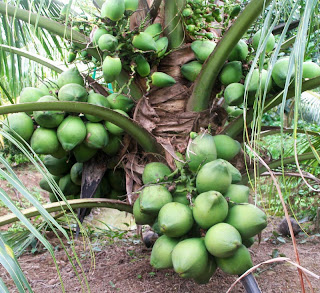
This mycorrhiza includes a fungus of the genus Amanita (Photo source Wikipedia)
It's the right time to imagine that the Philippine denuded mountains will be covered again with forever green grass and trees.
"It's a silent miracle worker and, best of all, it's organic,"
It may hurt the chemical fertilizers business but it would benefit the Mother Nature and the earth as it helps the farmers to have abundant harvest.
"mycorrhiza" is not expensive compared to chemical fertilizer and maybe soon accessible by the farmers to replace the commonly used chemical fertilizer.
Mycorrhiza in the Know
According to Wikipedia, a mycorrhiza (Gk. μυκός, mykós, "fungus" and ριζα, riza, "roots",pl. mycorrhizae or mycorrhizas) is a symbiotic (generally mutualistic, but occasionally weakly pathogenic) association between a fungus and the roots of a vascular plant.
In a mycorrhizal association, the fungus colonizes the host plant's roots, either intracellularly as in arbuscular mycorrhizal fungi (AMF or AM), or extracellularly as in ectomycorrhizal fungi. They are an important component of soil life and soil chemistry.
Philippines banks on fungus to plant 1.5 billion trees
Fungus converts previously useless earth around it into healthy soil
To help it achieve the goal of planting 1.5 billion trees by 2016, the government is counting an unlikely ally — a rare fungus that converts previously useless earth around it into healthy soil.
According to Department of Environment and Natural Resources (DENR) Secretary Ramon Paje, the government has found a partner in "mycorrhiza" a fungus which the official said would not just help the country plant more trees, but will also wean away Filipino farmers from dependence on non-organic fertilizers.
Mycorrhiza, being a fungus, is inexpensive and can be grown anywhere, he said. It is also safe in comparison to chemical fertilizers that can harm the environment and humans.
"It's a silent miracle worker and, best of all, it's organic," Paje said, adding that the Philippine government had adopted a policy on the wide use of mycorrhiza in agricultural and forestry applications.
"This policy on the use of mycorrhiza has in effect boosted government efforts to encourage the use of organic fertilizers to wean away farmers from chemical fertilizers in order to improve the health of soil throughout the country," he said.
The depletion of the country's forest cover had been largely blamed for calamities such as flash floods that occur in the Philippines with increasing regularity.
According to experts, the country has lost as much as 80 per cent of its natural forest cover.
Based on the 2001-2003 satellite imagery, the Philippines' remaining forest cover is estimated at 7.168 million hectares, or 24.27 per cent of the total land area. The remaining eight million hectares are unproductive, open, denuded or degraded.
In a bid to rehabilitate and restore the country's forest cover, the government of President Benigno Aquino launched the National Greening Program (NGP). Part of this scheme is promoting a new approach to reforestation where the mycorrhiza plays a big role.
Paje explains that other than serving as a fertilizer for trees, mycorrhiza can be used on other crops.
"Aside from trees, mycorrhiza can even be applied on a variety of crops, including sugarcane, onions, garlic and vegetables. It's cost-effective. The cost of adding mycorrhiza is lower than the savings from reduction in chemical fertilizer use. The yield gains add to the profits,'' he said,
Mycorrhiza promotes plan growth by enhancing a plant's uptake of water even in arid or acidic soils. At the same time, it also releases powerful enzymes into the soil that dissolve hard-to-capture nutrients such as organic nitrogen, phosphorus, iron and other "tightly bound" soil nutrients.
According to experts, mycorrhizal fungus possesses "symbiotic ties with plants".
"It attaches itself either on or inside the plant roots to tap into the sugars and carbohydrates present in the leaves for its sustenance. In turn, the fungal hyphae (filaments) grow out from the roots and bring water and soil nutrients back into the plant host," the DENR said.
The Philippines' studies on the workings of this wonder fungus were the result of the efforts of Dr Evangeline T. Castillo of the Ecosystems and Research Development Bureau (ERDB).
"Through her work, ERDB has produced pure inoculants of endomycorrhiza which now have two approved patents from the Bureau of Patents of the Intellectual Property Office-Philippines," said the DENR.
With report from the Gulf News















